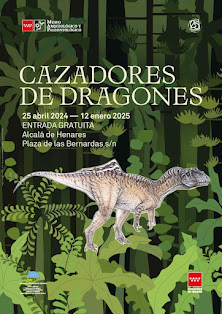Miembros del Grupo de Biología Evolutiva de la UNED han presentado durante las IX Jornadas Internacionales sobre la Paleontología de Dinosaurios y su entorno, el trabajo titulado “New data on the appendicular skeleton of the simosaurid Paludidraco multidentatus holotype (Eosauropterygia), from the Upper Triassic of El Atance (Guadalajara, Spain)” como comunicación oral. En esta comunicación se ha presentado un estudio anatómico preliminar de los elementos apendiculares pertenecientes al holotipo del recientemente descrito taxón español Paludidraco multidentatus (Eosauropterygia, Simosauridae), procedente del Carniense (Triásico Superior) del yacimiento paleontológico de El Atance (Guadalajara, España). A continuación, os dejamos el resumen perteneciente a este trabajo:
Simosauridae is a clade of Triassic eosauropterygians ranging from the Anisian or Ladinian (Middle Triassic) to the Carnian (Late Triassic) of the Middle East and Europe. Simosauridae was erected by Huene in 1948 after the description of Simosaurus gaillardoti (from the Ladinian of France and Germany) by Meyer in 1842, that taxon being the type species for the group and the only known valid representative of the clade until recently. Nevertheless, a new eosauropterygian (i.e., Paludidraco multidentatus) was described by de Miguel Chaves et al. (2018) from the Carnian fossil site of El Atance (Guadalajara, Central Spain), being recognized as a member of Simosauridae. Despite the holotype of the Spanish taxon corresponded to a relatively complete skeleton preserving several of the appendicular elements, its postcranium has not yet been studied in detail. Appendicular elements of S. gaillardoti are relatively well-known specially based on the information provided by Rieppel (1994). Simosaurus gaillardoti was recognized as an active predator whereas Paludidraco multidentatus shows non-appendicular anatomical features associated to a significantly different lifestyle (e.g., slender mandibles with numerous and small comb-like teeth; and pachyostotic ribs and vertebrae), presenting adaptations for slow movement near the marine bottom. In this context, a detailed description of the appendicular elements preserved in the holotype of P. multidentatus is performed here, in addition to an anatomical comparative study with those of its sister taxon S. gaillardoti. The functional implications and locomotion modes previously proposed for both taxa will be reevaluated considering the different character states between their appendicular skeletons.
-----
Más información:
- Imagen: Comunicación oral del trabajo presentado el 09/10/22 durante las IX Jornadas Internacionales sobre la Paleontología de Dinosaurios y su entorno.
- Referencia: Cabezuelo Hernández, A., de Miguel Chaves, C., Ortega, F., Pérez-García, A. 2022. New data on the appendicular skeleton of the simosaurid Paludidraco multidentatus holotype (Eosauropterygia), from the Upper Triassic of El Atance (Guadalajara, Spain). Libro de Resúmenes de las IX Jornadas Internacionales sobre la Paleontología de Dinosaurios y su entorno, 58-59.





























No hay comentarios:
Publicar un comentario